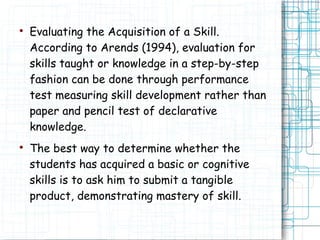Teaching Basic Skills Through Direct Instruction
- 1. Teaching Basic Skills Through Direct Instruction
- 2. The Nature of Direct Instruction DIRECT INSTRUCTION - is a deductive instructional strategy that is taught in a step-by-step fashion. According to Gagne (1985), it can be used in teaching procedural knowledge and declarative knowledge.
- 3. PROCEDURAL KNOWLEDGE – deals with basic academic skills, learning and thinking skills and the skill components od various learning areas in curriculum. Some Examples of Procedural Knowledge are computational skills, reading and writing skills, library research skills, note taking skills and analysis and evaluation skills
- 4. Mathematics Languages Physical Education Livelihood Education Music Social Studies Procedural Knowledge Declarative Knowledge Curriculum areas, like Social studies, have more declarative knowledge, which cannot learned without the mastery of basic learning and thinking skills.
- 5. Direct instruction is called in several names in research literature: skill instruction, mastery teaching, explicit skill instruction and training model (Joyce & Weil, 1992). According to Louisell and Descamps (1992), this strategy has three basic characteristics, namely: ~ The teacher presents and demonstrates a procedural knowledge ~ The students asked questions to verify understanding; and ~ The students practice the skill guided and independent condition until the skill is prepared.
- 6. The major purpose of Direct Instruction is to teach basic academic skills, learning skills and teaching skills in a way that leads to transfer. There are 3 major roles a teacher has to play in direct instruction. 1. Focus on attention 2. Coaching role 3. Assessing their progress and degree of mastery.
- 7. Phases of Direct Instruction Phase 1: Stating Objectives and establishing Set. The teacher states the objectives of the lesson and presents background information... Phase 2: Demonstrating or Modeling the skills or knowledge. Teacher demonstrates the skills correctly or presents step-by-step information.
- 8. Phase 3: Providing Guided Practice. The teacher provide initial and guided practice. Phase 4: Checking for Understanding and Feedbacking. The teacher checks to see whether the students are performing correctly and provides feedback. Assigning Independent Practice. The teacher provides independent practice after he is convinced that students can work by themselves with minimal teacher intervention.
- 9. Preparing Objectives To be able to formulate skill-oriented objectives, the teacher has to undertake tasks analysis. Through tasks analysis the teacher can define precisely what the students has to do to perform the desired skill.
- 10. According to Arends (1994), tasks analysis can be done through the ff. ways: ~ Find out what a knowledgeable person does when the skill is performed. ~ Divide the overall skill into sub-skills. ~ Put sub-skills in some logical order. ~ Design strategies to teach each of the sub- skills and how they are combined.
- 11. Facilitating Learning Through Direct Instruction Providing objectives and Establishing Set. The teacher begins the lesson by explaining the objectives and establishing learning set. Conducting Demonstration. Direct instruction of a skill or concept relies heavily on demonstration. Demonstrating a particular concept or skill requires two things from a teacher: a thorough understanding or mastery of the concept or skill demonstration; and careful rehearsal of all the aspects of demonstration before the actual classroom event.
- 12. Providing Guided Practice. It is a critical step in direct instruction. There are three values of guided practice in teaching a skill or concept through direct instruction. ~ Retention of a skill or concept is increased with active practice. ~ Learning of a skill or concept becomes automatic. ~ The student is able to transfer learning to new or stressful situations.
- 13. There are three principles teachers have to consider when providing guided practice (Arends,2004). ~ Assign short, meaningful amounts of practice. ~ Assign practice to increase overlearning. ~ Attend to the initial stages of practice.
- 14. Checking Understanding and Providing Feedback. Practice will be of less value without knowledge of result. Providing students with meaningful feedback or knowledge of result is the most important task of teacher using direct instruction. Assigning Independent Practice. Most teachers employ homework in providing independent practice for their students. Through the homework, students are provided the opportunity to perform the newly acquired skill on their own.
- 15. Evaluating the Acquisition of a Skill. According to Arends (1994), evaluation for skills taught or knowledge in a step-by-step fashion can be done through performance test measuring skill development rather than paper and pencil test of declarative knowledge. The best way to determine whether the students has acquired a basic or cognitive skills is to ask him to submit a tangible product, demonstrating mastery of skill.
- 16. To determine if a student has mastered a psychomotor skill, the teacher needs to observe the student performing the skill. Such skill include handwriting, drawing, dancing, jumping and the like. ~ The END ~















